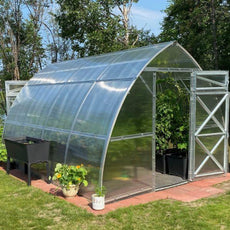In this article, you will learn:
- Characteristics of Malta’s Planting Regions
- Challenges of Growing in Malta
- The Benefits of Using a Greenhouse in Malta
With temperatures rising past 40°C during peak summer and rainfall becoming increasingly erratic, Maltese gardeners must adapt quickly to preserve their plants and harvests. Though the island’s compact size and consistent sunshine offer advantages, its exposure to sea winds and limited freshwater resources present real challenges for horticulture.

Image from Plant Maps
Characteristics of Malta’s Planting Region
Malta’s Mediterranean climate shapes its gardening environment in the following ways:
- Long, dry summers with temperatures regularly above 35°C
- Short, mild winters with little risk of frost
- Low annual rainfall, mostly concentrated in autumn and winter
- High humidity levels, especially near coastal areas
- Frequent hot winds such as the sirocco, carrying dust from North Africa
- Limited natural freshwater sources for irrigation
- Thin, alkaline soils, often requiring soil amendment for better yields
Due to these factors, the ideal planting seasons in Malta are typically autumn (October–December) and late winter to spring (February–April). However, extreme summer heat can reduce yield and even halt outdoor cultivation unless shade or greenhouse protection is used.
Challenges of Growing in Malta
Extreme Heat
Summers in Malta can be scorching, with temperatures often exceeding 40°C. Prolonged heat stress can scorch leaves, dry out soil rapidly, and reduce plant productivity.
Water Scarcity
Malta has no rivers or lakes and depends on desalinated seawater and limited groundwater. Water conservation is critical, making irrigation efficiency a top priority for gardeners.
Coastal Winds
Strong winds, especially from the north and east, can dry out soil and damage delicate plants. Windburn and salt exposure are constant concerns for those near the sea.

The Benefits of Using a Greenhouse in Malta
Greenhouses provide a controlled environment that helps Maltese gardeners overcome heat, wind, and water-related challenges, extending the planting season and increasing the variety of crops that can thrive.
1. Extend your growing season
- Without a greenhouse:
Outdoor gardening in Malta is largely restricted to the cooler months (October–April). During the hot summer, many plants either bolt or wilt, halting production entirely.
- With a greenhouse:
A ventilated and shaded greenhouse allows for year-round growing. With added cooling systems like automatic vents or shade cloths, even summer cultivation becomes possible, especially for heat-sensitive crops.
2- Grow a Wider Variety of Plants
- Without a Greenhouse:
Maltese gardeners typically grow drought-tolerant vegetables such as:
|
Tomatoes Peppers Eggplants Zucchini Lettuce |
Onions Peas Berries Olives Artichokes |
- With a Greenhouse:
A greenhouse in Malta opens up opportunities to grow more delicate or exotic crops year-round, including:
|
Tomatoes Cucumbers Strawberries Carrots Eggplants Corn |
Leafy greens Berries Microgreens Herbs Peas Asian greens |
Radishes Spring onions Microgreens Baby turnips Broccoli Okra |





